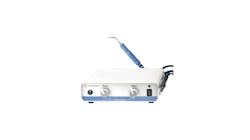Chairside Impact: The Autoscaler Ultrasonic System from Pac-Dent
As a former dental hygiene student, you may recall learning in your oral pathology and embryology classes that the human fetus is developed and safeguarded in a sterile environment within the mother’s womb.1 It isn’t until childbirth that babies are introduced to bacteria in the birthing canal and significantly more pathogens as they explore the world with their mouths, are transferred microbes from well-meaning caregivers, and acquire their primary teeth. You might say that we are born with a microbial clean slate, and research shows that the subsequent accumulation of bacteria and the sticky biofilm they inhabit is a leading contributor to oral disease and a wide array of systemic illnesses.2 When it comes to caring for patients in the dental hygiene chair, biofilm disruption and removal plays a significant role, not only in the fight for oral health, but in patients’ overall well-being.
More Chairside Impact:
- Chairside Impact: Tipped interdental brush from Summit Oral Care
- Chairside Impact: DentalPost.net
- Chairside Impact: The Dental Pain Eraser by Synapse
Pac-Dent’s Autoscaler Ultrasonic System is an effective tool in the management of disease-causing biofilm. With over 40 years of experience in supporting clinicians with expert-level performance, the Autoscaler is a device that hygienists can rely on for precision, power, and convenience. Available in both 25K and 30K models, the intense acoustic vibrations released from the insert’s working end, in combination with the lavage action from the unit’s continuous fluid irrigation, detach and inactivate microbial colonization at the gingival margin, in hard-to-reach interproximal spaces, and in deep, infected subgingival pockets.
Using the Autoscaler is simple and straightforward, as all the operator adjustments occur on the front of the unit. There’s no need to blindly feel your way along the back or underside of the device to find the power switch, as it’s easily visible right next to the water and power knobs on the Autoscaler’s face. These accessible features allow for smooth hygiene care, as well as reduced ergonomic strain due to frequent operator movement while finding device controls. Additionally, the small dimensions of this system allow it to easily accommodate most dental hygiene settings, whether it be a tight operatory with limited storage space or a mobile care environment where a simple, portable setup is needed.
Any leading manufacturer’s magnetostrictive insert tips can be used with the Autoscaler, but Pac-Dent’s universal and thin inserts make for sensible accompaniments to this ultrasonic system. They feature a nonslip grip to allow for improved tactile sensitivity and use a base flow water delivery. The universal tip is suitable for use in nearly any scaling scenario, while the slim insert is more appropriate for tight, delicate areas where the primary objective is biofilm removal. They are compatible with most other magnetostrictive systems, allowing them to be versatilely used in offices that have more than one brand of ultrasonic scaling device.
While our patients may never attain the same microbial clean slate that they once had as newborns, we as dental hygienists play a vital role in decreasing the diversity and prevalence of harmful pathogenic biofilm in our patients, which will ultimately return them to symbiosis. Magnetostrictive ultrasonic instrumentation is one highly effective way of accomplishing this goal, and the Autoscaler by Pac-Dent is a reliable, cost-effective system that provides clinicians with the control and accuracy needed to tackle any type of biofilm they are presented with. If our patients’ mouths become healthier, we can expect to have systemically healthier patients, too! The Autoscaler can help dental health-care professionals treat the whole patient—which is a powerful, profound privilege.
Editor's note: This article appeared in the September 2022 print edition of RDH magazine. Dental hygienists in North America are eligible for a complimentary print subscription. Sign up here.
References
- Haug RH. The changing microbiology of maxillofacial infections. Oral Maxillofac Surg Clin North Am. 2003;15(1):1-15. doi:10.1016/s1042-3699(02)00076-6
- Maddi A, Scannapieco FA. Oral biofilms, oral and periodontal infections, and systemic disease. Am J Dent. 2013;26(5):249-254.
About the Author

Bethany Montoya, MBA, RDH
Bethany Montoya, MBA, RDH, is a practicing dental hygienist, educator, industry key opinion leader, and editorial director of DentistryIQ’s Clinical Insights newsletter. She has a passion for advancing modern disease prevention. She specializes in exploring the intersection of clinical practice, professional growth, and innovation within oral health care. Through her writing, she aims to educate, inspire, and spark meaningful dialogue in the dental community. She can be reached at [email protected].
